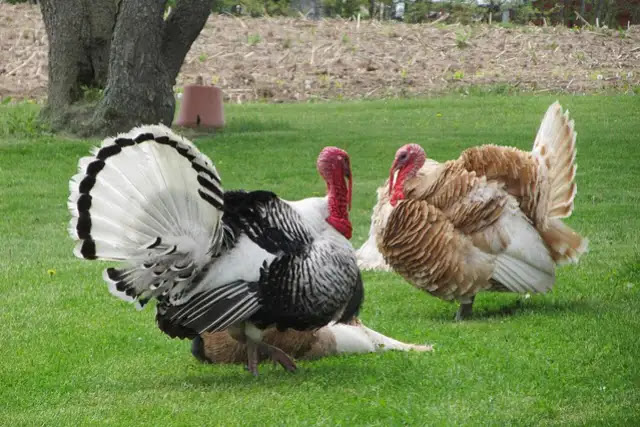If you're curious about one of America's most beloved birds, look no further than the turkey. From its unique physical characteristics to its history as a domesticated animal, the turkey has captured the attention of people for centuries. In this article, we've compiled 57 fascinating facts about the turkey bird that are sure to entertain and educate.
57 Fascinating Facts About the Versatile Turkey Bird
- The turkey is a large bird in the family Phasianidae.
- The wild turkey is native to North America and was domesticated by the indigenous peoples of Mesoamerica.
- The domesticated turkey is a subspecies of the wild turkey.
- The scientific name of the domesticated turkey is Meleagris gallopavo.
- Turkeys have a distinctive fleshy wattle that hangs from their neck, called a snood.
- Turkeys also have a fleshy protuberance on their head called a caruncle.
- The males are called toms, while the females are called hens.
- Adult males have a long, fan-shaped tail and iridescent feathers.
- The feathers on the head and neck of male turkeys can change color depending on their mood.
- Female turkeys have a smaller, more rounded tail and duller plumage.
- The turkey is one of the most popular birds in the United States.
- The turkey was originally domesticated by the indigenous peoples of Mexico.
- Turkeys were brought to Europe by Spanish explorers in the 16th century.
- The first Thanksgiving feast in the United States likely included wild turkeys.
- Turkeys are typically raised for meat.
- Turkeys are also sometimes kept as pets.
- Wild turkeys can fly short distances and are strong runners.
- Domesticated turkeys are too heavy to fly.
- Turkeys have a lifespan of 3-5 years in the wild and up to 10 years in captivity.
- Turkeys have excellent eyesight and hearing.
- Turkeys have a poor sense of smell.
- Turkeys are social animals and will often roost together.
- Turkeys communicate with each other through a variety of vocalizations.
- Turkeys are omnivores and will eat insects, seeds, and fruit.
- Turkeys have a crop, a muscular pouch near their throat, which helps them digest food.
- Turkeys have a gizzard, a muscular organ in their digestive system that grinds up food.
- Turkeys can drink up to a gallon of water a day.
- Turkeys have a unique mating system where males compete for access to females.
- Male turkeys will display for females by puffing out their feathers, strutting, and making vocalizations.
- Female turkeys will select a male based on his display and mating calls.
- The courtship and mating season for turkeys is in the spring.
- Turkeys lay eggs in a nest on the ground.
- Female turkeys can lay up to a dozen eggs in a clutch.
- Turkeys are sometimes used as a symbol of American nationalism and pride.
- Turkeys are also sometimes associated with Thanksgiving and Christmas.
- The largest turkey on record weighed over 86 pounds.
- Turkeys have been known to attack humans.
- The red skin on a turkey's head and neck can change color depending on its emotional state.
- Turkeys have a sharp beak and powerful legs.
- The turkey's beak contains a sensory organ called the Bill Tip Organ, which allows them to sense vibrations and detect small prey.
- Wild turkeys can run up to 25 miles per hour.
- The turkey was almost chosen as the national bird of the United States instead of the bald eagle.
- Benjamin Franklin famously preferred the turkey as the national bird.
- The turkey is the state bird of Massachusetts.
- In some cultures, turkeys are considered a symbol of fertility and abundance.
- In the United States, turkeys are raised on farms in large numbers and are a major agricultural product.
- The turkey industry in the US produces around 245 million turkeys annually.
- The most common breed of turkey raised for meat is the Broad Breasted White.
- Turkey meat is low in fat and high in protein.
- Turkey meat is a good source of vitamins B3 and B6, as well as selenium and zinc.
- Turkey meat is a common ingredient in sandwiches, salads, and stews.
- Turkey feathers are sometimes used for decoration and crafts.
- Turkey bones can be used to make broth and stock.
- Turkey manure is a valuable fertilizer for crops.
- The turkey vulture, a species of bird found in the Americas, is sometimes called a turkey buzzard due to its similar appearance to the turkey.
- Wild turkeys were almost hunted to extinction in the early 20th century, but conservation efforts have helped to increase their populations.
- Turkey hunting is a popular recreational activity in North America, and many states have established hunting seasons and regulations to manage wild turkey populations.
From its significance in American history to its popularity as a holiday centerpiece, the turkey is a fascinating and versatile bird. Whether you're interested in its biology, behavior, or cultural importance, there's always something new to learn about this iconic animal. With these 57 facts about turkey, you'll be sure to impress your friends and family with your knowledge of this amazing bird.














0 Comments